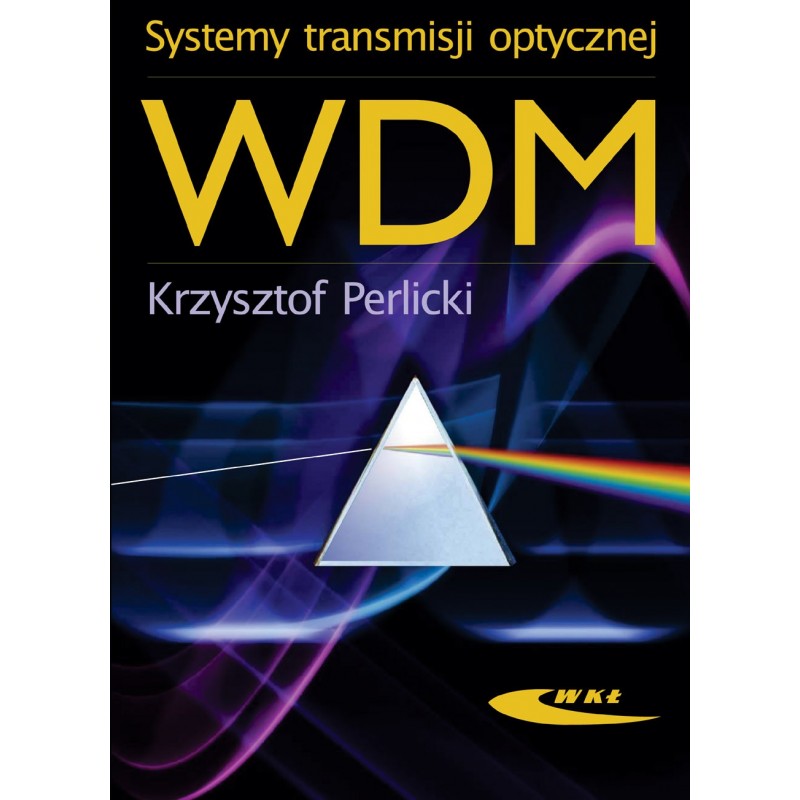- Out-of-Stock



Krzysztof Perlicki
Krzysztof Perlicki ISBN: 978-83-206-1646-0 format B5, p. 256, fig. 182, tab. 58, hardcover Price: PLN 40.00 Academic handbook on the technique of multiplication in the field of wavelength (WDM), which is one of the basic modern telecommunications techniques, enabling the implementation of very high bandwidth transmission, used in long-range systems and access networks. WDM systems architecture, physical phenomena affecting performance and abuse in WDM systems, as well as standardization and layered model as well as design and practical implementations as well as WDM systems testing methods have been described. A handbook for students of electronics, telecommunications and related fields, post-graduate students and for people who, due to their profession, have direct contact with modern telecommunications systems. Table of contents: Introduction 7
Chapter I
Introduction 9
Literature 14
Chapter II
Selected components of WDM 15 systems
2.1. Light sources 15 2.2. Optical amplifiers 20 2.2.1. Optic amplifiers doped with rare earth elements 21 2..2.2. Raman amplifiers 25 2.2.3. Semiconductor amplifiers 28 2.3. Wavelength converters 30 2.3.1. Optoelectronic converters 30 2.3.2. Purely optical converters 31 2.4. Regenerators 3R 33 2.5. Wave machines 36 2.6. Optical transfer multiplexers 41 2.7. Optical distribution boxes 43 2.8. Chromatic dispersion compensators 46 2.9. Polarizing dispersion compensators 51 2.10. Telecom optical fibers 55 References 57 Chapter III Mitigating phenomena of WDM 60 systems 3.1. Cross-channel listening 60 3.1.1. Balance of optical power of the WDM 60 system 3.1.2. Determination of crosstalk between WDM 62 channels 3.1.3. Impact of shot noise on the change in the system power balance 66 3.1.4. The effect of crosstalk on the elementary error rate level 67 3.1.5. The impact of inter-channel crosstalk on the synchronization of the telecommunications network SDH 71 3.2. Channel crosstalk 71 3.3. The influence of reflections on point inclusions in optical fiber connections 72 3.4. The phenomenon of broadcasting optical carriers 75 3.5. Non-linear phenomena in WDM 78 systems 3.6. Limited optical band 92 3.7. Chromatic and polarizing dispersion 93 3.7.1. Chromatic dispersion 94 3.7.2. Polarizing dispersion 99 3.8. Noise Amplifier 101 References 103 Chapter IV Selected Issues in the Design of WDM Systems 105 4.1. The criterion for assessing the quality of work of the optotelecommunications systems 105 4.2. Balance of optical power 109 4.3. Chromatic dispersion 114 4.4. Polarizing dispersion 122 4.5. Distribution of channels 124 4.6. Non-linear phenomena 128 4.7. Numerical modeling 130 Literature 134 Chapter V Organization of WDM systems 136 5.1. Construction of the optical transport network 136 5.2. Data transfer units 139 5.3. Headings 142 5.4. Creating an optical transport module 148 5.5. Mapping of external signals 149 5.6. IrDI and IaDI interface 151 5.7. Management 152 Literature 158 Chapter VI WDM Techniques in Telecommunications Systems 159 6.1. WDM technology in access networks 161 6.2. WDM technique in urban networks 170 6.3. WDM technology in long-distance networks 177 6.4. IP broadcast after WDM 186 Literature 198 Chapter VII Abuse in WDM 200 systems 7.1. Types of fraud 200 7.2. Unauthorized access 200 7.3. Impersonating 205 7.4. Jamming 205 7.4.1. Jamming in the band 205 7.4.2. Jamming outside the band 206 7.5. Places exposed to attacks 210 7.6. Fraud detection and elimination 213 References 214 Chapter VIII. Normalization of WDM systems 216 8.1. Normalization ETSI 216 8.2. Normalization of lEC 217 8.3. ITU Standardization 217 8.4. Documents of Telcordia 228 Chapter IX. Research on the quality of WDM systems 233 9.1. Monitoring methods 233 9.2. Measuring instruments 248 9.3. Example of monitoring system design 249 Literature 253 Important shortcuts 255
Krzysztof Górski
No product available!
Module with 4-channel DC motor driver (2 x TB6612FNG) designed for FireBeetle boards. It communicates via the I2C interface. DFRobot DFR0508
No product available!
No product available!
Evaluation board with LPC1768, USB, Ethernet, NGX Technologies, RoHS
No product available!
Matrix display module with Raspberry Pi Pico W control board. It has built-in 583 RGB LEDs in a 53 x 11 layout, an amplifier with speaker and buttons. Ideal for building a clock, displaying sensor data or presenting weather data. Pimoroni PIM631
No product available!
No product available!
A minisumo robot on a tracked chassis with Pololu 50:1 HP motors. Fully assembled robot, additionally requires four AA batteries. Pololu 3125
No product available!
Permanent cylindrical neodymium magnet with a diameter of 10 mm and a height of 4 mm.
No product available!
No product available!
No product available!
An advanced temperature control module that offers many functions and possibilities for both home and commercial applications. It is perfect for controlling water heating, both radiators and water underfloor heating, but an additional 230V solenoid valve or electrothermal head is required. BleBox thermoBox
No product available!
Fanciers of fine automobiles will absolutely fall in love with Ugears\' Dream Cabriolet VM-05 wooden car model. This 1950s throwback is a beautiful showpiece but what really sets it apart is the model comes loaded with a host of moving parts and realistic detail. The Dream Cabriolet is an absolute marvel of design, featuring: a hood that lifts to reveal a V8 engine with moving pistons; a trunk that lifts to reveal the winding knob; transmission lever on the steering column that puts the car into reverse, idle or drive gear; front and rear suspension; doors that open and seats that push forward to let passengers in the back; and functional window cranks and windshield wipers. UGears 70073
No product available!
No product available!
AVT kit for self-assembly of the educational board for Arduino. AVT5636 B
No product available!
The assembled relay card programmed with sequences. AVT1998 C
No product available!
No product available!

Krzysztof Perlicki
